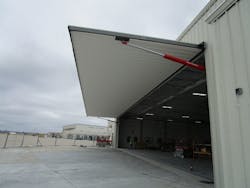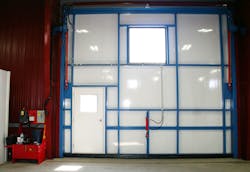Hydraulic systems are often the first choice for opening and closing gigantic one-piece doors used on airplane hangars, agricultural buildings, and structures requiring large openings. Sometimes exceeding 100 ft. in width and weighing well over 10,000 lb., these doors need powerful mechanisms to operate smoothly and dependably. Hydraulic power is ideal and adaptable to any size door by increasing cylinder size in proportion to door size and weight.
One-piece doors are preferable in these applications because they swing up and away from the building, and their operation is simple. They do not protrude inside the structure like roll-up doors, which can reduce headroom. Bifold doors, on the other hand, pivot outward as they are raised. This feature presents a different set of advantages and disadvantages. Because bifold doors lift from the bottom, lifting force can be distributed across the width of the door. An electromechanical drive is generally used for these doors, but because one-piece doors must be pivoted from both sides, hydraulics is generally used.
A big advantage of the one-piece doors is that they provide a large, shaded canopy outside the building when open. With hydraulic power, the doors can be clad with almost any material, including heavy glass and steel siding. Entire storefronts have been incorporated into door designs.
This example is more typical of a one-piece hydraulic door, which in all sizes and from variety of materials provide easy access for aircraft hangers, as well as agricultural, industrial, and residential buildings.
Smart Hydraulic Design
Schweiss Doors, Hector, Minn., offers both types and has developed design features specifically addressed to improve hydraulic door operation over other designs. At the heart of the company’s system is a hydraulic gear pump driven by an electric motor ranging in size from 2 to 20 hp. The complete hydraulic power unit (HPU) is a compact package that can be mounted anywhere in a building, whether on the floor or a wall close to the door or farther away.
UL-listed electrical components are housed in control boxes, including contactors, transformers, relays, motor timers, rectifiers, and control fuses. The gear pump is 95% efficient and operates quietly at 1,800 rpm. The HPU also incorporates a 3,000-psi pressure gauge, fluid temperature gauges, and a service filter.
Structural features include a proprietary hinge design that provides considerably greater surface area than standard hinges for distributing the load of the moving door evenly. The patented hinges each feature four connection points, with grease-lubrication and removable hinge pins for extended service life. Spherical bearings connecting cylinders on each side of the door to the door frame and the building accommodate horizontal movement or deflection. They also allow for flexibility of the door and frame without binding on the cylinder pins and brackets.
This inside view shows the retracted position of the cylinders, as well as the hydraulic power unit at left. The recently introduced optional wind pin, visible at the lower center of the door, uses another cylinder to lock the door in the closed position to protect against strong winds.
The Hydraulic Solution
Mike Schweiss, president of Schweiss Doors, says hydraulics are a powerful, clean, simple, and trouble-free method of operating the doors, and they operate smoothly and quietly. He says the company uses cylinders with larger rod diameters than required for added strength and safety, with rod diameters from 1½ in. to 4 in., depending on door height, size, and weight. He also notes that the cylinders are beefed up and strengthened at critical points to avoid putting stress on the cylinders or cylinder pins.
Because of their size and weight, large hydraulic doors require safety features to prevent damage or injury from uncontrolled closing because of a power outage or failure of a hydraulic line. Schweiss incorporates counterbalance valves on all doors, causing the door to lock instantly in any position when not being operated, even if a hydraulic line should leak or burst. Pumps are driven by continuous-duty motors protected by fuse and overload devices. Low-voltage 24-V dc control stations with low-voltage coil connectors provide greater worker safety.
This HPU includes a rechargeable battery to allow operating the door in the event of a facility power failure. The HPU can also be mounted above ground on a wall or in a remote location.
Additional features include several alternative methods to operate the door safely in case of power failure. Each unit comes with a standard tractor hydraulic connection, which is particularly useful for agricultural or industrial applications. A built-in manual override allows an operator to lower the door during a power outage, and a DC battery backup also is equipped with a hex head that allows an impact wrench or drill to operate the door in either direction if necessary.
Schweiss explains that all of the hydraulic oil in the system that passes through the directional valve gets filtered. There is a small amount of oil in the cylinder and the hard lines that never gets back into the tank to mix with the oil that gets filtered. The pump includes a filter-clogging indicator that shows when to change the filter element, which also reduces any chance of an oil mess. The system’s 3,000 psi pressure gauge is standard and shows the pump pressure used to open the door.





